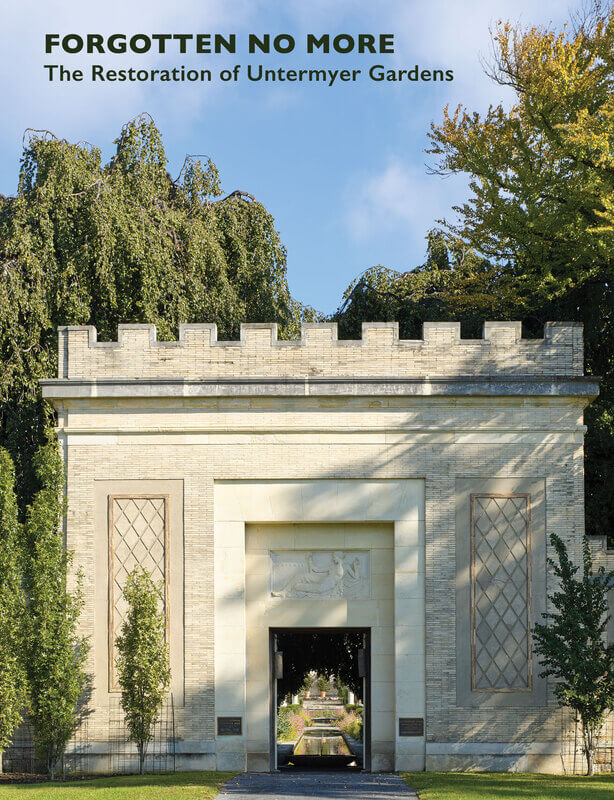Review of Forgotten No More: The Restoration of Untermyer Gardens, by the Untermyer Gardens Conservancy
Review by Michael Quinn
Who’s up for a day trip? It’s helpful if you have a car, but not necessary. You can get to Yonkers from Grand Central Station in less than an hour. Now, I know what you’re thinking: Yonkers? What do I want to go to Yonkers for? In a word: paradise.
Forgotten No More: The Restoration of Untermyer Gardens recounts the remarkable transformation of a neglected public park into an overwhelmingly beautiful green space with breathtaking views of the Hudson River. Produced last March by the Untermyer Gardens Conservancy to mark its tenth anniversary, Forgotten No More serves as “a record of its accomplishments and aspirations.” It features interviews with the Conservancy’s founder, board chairs, and head gardener, along with more than100 color photographs of the property, including an Indo-Persian walled garden, a terraced stairway framed by a pair of ancient Roman marble columns, and a gazebo perched atop a rocky cliff’s cascading waterfalls.
As you might be realizing, Untermyer Gardens is not your typical public park. There are fish in ponds, plants in pots, and the most stunning architectural details, some of them more than 2,000 years old. By rough estimate, more than 125,000 visitors explored the gardens’ 43 acres last year. No doubt many of them are repeat ones. There is so much to discover, and something different to enjoy each season. The gardens are open all year long—and admission is free. I’ve been twice (once in summer and once in fall) and both times I’ve been blown away by the beauty of the place. It’s so close to the city yet you feel transported to a totally different world. Flipping through Forgotten No More rekindles what I felt when I was there: a rare combination of awe (of its beauty), admiration (for the work it takes), and gratitude (that it exists at all—and that it’s open to everyone).
The book recounts the fascinating history of the place. The gardens’ namesake, Samuel Untermyer, born in 1858, was a self-made man who ran one of the most successful Jewish law firms in the United States. A social reformer, suffragist, and outspoken critic of Nazism in the 1930s, he and his wife Minnie were the rare type who used their wealth for worthy causes. They bought the property in 1899 with the ambition of creating the world’s finest garden—and of sharing it with the public. Thousands ambled through the grounds every year, their jaws no doubt dropping from the spectacular scenery. Isadora Duncan and her famous troupe of modern dancers took fluttering leaps across its lawns, twice, overlooked by the amphitheater’s two sphinxes.
The gardens required a huge staff of 60 gardeners to maintain. After Untermyer’s death in 1940, none of his survivors were willing or able to take on the upkeep. The City of Yonkers acquired part of the property in 1946, some land was sold off, and what was left fell into a steep decline. Over the ensuing years, the gardens were neglected and vandalized. The serial killer David Berkowitz, a.k.a. the Son of Sam, lived nearby and allegedly was one of the seedy types who made the place their new hangout. Statues were stolen, the walls covered with graffiti, and the grounds littered with old mattresses, broken bottles, and used syringes.
The Conservancy’s founder and president, Stephen F. Byrns, recalls first seeing the gardens in the 1980s, full of weeds and trash. As an architect, he was no doubt intrigued by the garden’s good bones, and the more he learned about its history, the more interested he became. Byrns devoted himself to turning the place around, helping to raise money and organize the necessary labor. He eventually gave up his Manhattan practice to tend to the garden’s wellbeing full-time.
Today, Yonkers continues to own the gardens, and the Conservancy does its work in partnership with the Parks Committee and the city’s mayor. It can’t be easy. How do they do it?
Byrns credits his and head gardener Timothy Tilghman’s “shared can-do attitude and intense ambition” for the gardens’ remarkable turnaround and success. With the help of local Boy Scout troupes, they carted out truckloads of garbage and excavated many of the gardens’ long-buried features, such as a totally concealed streambed rock garden. Tilghman has a handful of gardeners to help him now, but when you see the work he’s done in Forgotten No More, it looks like it would have taken an army. It’s clear that this garden is and always has been a labor of love. In many ways, it stands as a testament to the amazing things we can accomplish when we work together toward a vision that uplifts and serves everyone.
For the armchair travelers among us, Forgotten No More captures the garden in all its seasonal glory: the pastel airiness of spring, the tropical lushness of summer, the golden richness of fall, and the icy clarity of winter. For anyone with an interest in architecture, horticulture, or conservation, this book (and this garden) has it all. Forgotten No More is available only through the Conservancy’s website (untermyergardens.org) because the proceeds benefit its mission of restoring, interpreting, and enhancing the gardens. The beautifully produced hardcover book costs $25 (including shipping), or pay $20 and pick it up yourself on a weekend visit. It’s a short trip, and an unforgettable one.










One Comment
Hello Michael Quinn, in your opening comments you asked: “Yonkers? What do I want to go to Yonkers for?” Yonkers, the third largest city in New York State, is rich in history that dates back to the 1600s. And by the way, the trip from GCS to Yonkers station is only 30 minutes. Also, there is rich cultural history surrounding Untermyer Park that people will soon know about. Take care!